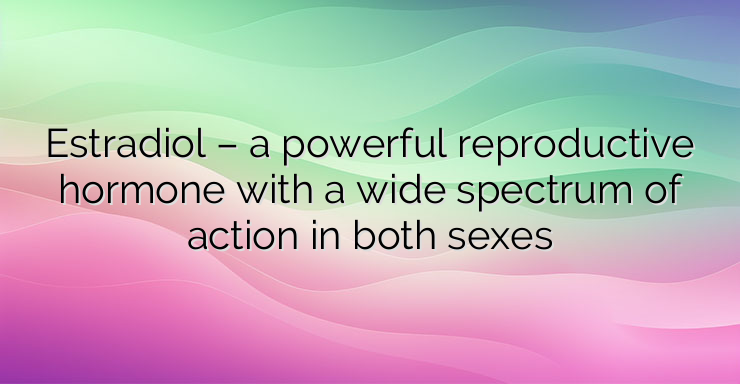Estradiol is a steroid hormone made from cholesterol and is the strongest of the three naturally produced estrogens. It is the main estrogen found in women and has many functions, although it mainly acts to mature and maintain the female reproductive system. The natural increase in estradiol concentrations in the blood during the menstrual cycle causes the egg to mature and be released, that is, it is responsible for ovulation. Another important role of estradiol is to thicken the lining of the uterus so that the egg can implant if fertilized. Estradiol also promotes the development of breast tissue and increases bone and cartilage density. In premenopausal women, estradiol is mainly produced by the ovaries. Estradiol levels vary throughout the monthly menstrual cycle, being highest at ovulation and lowest during menstruation. Estradiol levels in women decline slowly with age, with a large drop seen at menopause when the ovaries “shut down.” In pregnant women, the placenta also produces a lot of estradiol, especially towards the end of pregnancy. Men also produce estradiol, but the amounts produced are much lower than in women. In the testes, some of the testosterone is changed into estradiol, and this estradiol is essential for the production of seminal fluid. In both sexes, estradiol is produced in much smaller amounts by adipose tissue, the brain, and the walls of blood vessels. Estradiol production in women’s ovaries is controlled by hormones released by both the hypothalamus in the brain and the pituitary gland. This is called the female reproductive axis and is also known as the hypothalamic-pituitary-ovarian axis. The hypothalamus at the base of the brain releases a hormone called gonadotropin-releasing hormone. Gonadotropin-releasing hormone then acts on the pituitary gland to cause the release of two additional hormones, luteinizing hormone and follicle-stimulating hormone. These hormones enter the blood and stimulate the ovary, specifically acting on the cells that surround each egg, stimulating the follicle to grow and develop. In the final stages of growth and development, the cells around the egg will produce estradiol. After the egg is ovulated, the ovulated follicle will turn into a corpus luteum. The corpus luteum produces both progesterone and estradiol, and the main role of these two hormones is to ensure that the lining of the uterus is fully prepared for implantation should fertilization occur. The amount of estradiol (and progesterone) in the circulation communicates with the hypothalamus and pituitary gland to control egg development, ovulation and the menstrual cycle. In women, high estradiol levels can have a number of effects. In mild cases, excess estradiol can cause acne, constipation, loss of libido and depression. More serious effects may include weight gain, female infertility,stroke, heart attack and increased risk of developing uterine and/or breast cancer. Estradiol is needed for bone development, so people with low estradiol tend to have skeletal problems such as inadequate bone growth and osteoporosis. Girls will also face problems at puberty, such as delayed breast development, irregular or absent menstrual cycles, and infertility. Estradiol also plays an important role in the brain, where low levels can cause depression, fatigue and mood swings. A woman’s production of estradiol decreases naturally during menopause and causes many of her symptoms. Initially these include night sweats, hot flashes, vaginal dryness and mood swings, while in the long term osteoporosis is more likely to develop. Estradiol is used in hormone replacement therapy to relieve these menopausal symptoms in women. References: https://mft.nhs.uk/app/uploads/2020/09/Oestradiol.pdf


Leave a Reply